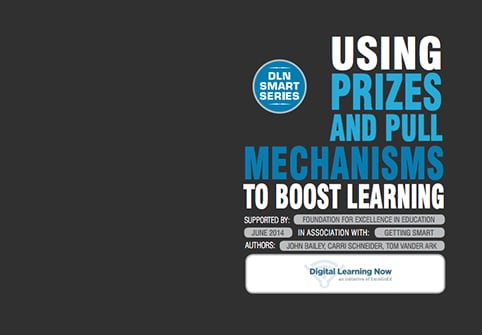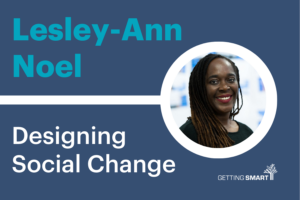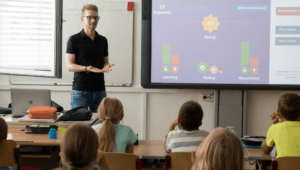10 Ways States Can Use Prizes & Pull Mechanisms to Innovate

At the National Summit on Education Reform I spoke about Using Prizes & Pull Mechanisms to Boost Learning. The Digital Learning Now paper explains the problem that pull mechanisms solve:
In healthy markets, participants respond to incentives, invest in research and development (R&D) and produce new innovations. Capital investments bring productivity to scale. In underdeveloped or inefficient markets (like education), customers have few choices, often controlled by bureaucratic mechanisms rather than market mechanisms, and there is little investment in R&D. Underdeveloped markets suffering from a lack of investment and innovation can be addressed through direct investment (return-seeking or philanthropic) by advocating for better policies, or through pull mechanisms.
The four typical pull mechanisms include:
- Market development: aggregated demand and advance market commitments. Digital Promise developed the League of Innovative Schools, in part, as a demand aggregation strategy. Social impact bonds–currently used in early learning and juvenile justice– are another form of market development mechanism. (Also see this Path paper to learn how AMC were used to expand access to HIV treatments).
- Fast track policies: cutting through the bureaucracy with accelerated approvals and proactive incentives.
- Inducement prizes: rewards for successfully meeting a breakthrough challenge or outcome (e.g., Hewlett sponsored Automated Assessment Scoring Prize).
- Leveling the playing field: creating a level regulatory space that invites non-traditional players to participate and offer solutions (see post on innovation zones).
Another good example of the creative use of prizes is The Foundation for Excellence in Education (@ExcelinEd) sponsored design challenge (#SchoolInfo) with up to $35,000 in prizes to help create more accessible and useful state report cards. Finalists are posted and voting is still open–pick your favorite now!
There are at least 10 ways states could use prizes and pull mechanisms to innovate and improve education:
- Social impact bonds to fund improved early learning, dropout prevention/recovery, improved youth/family support services, multidimensional foster care treatment, and education of adjudicated youth.
- Learning platform RFP issued by a state or partner nonprofit (potentially including student information system, open content library, standards-based gradebook) could provide access to a cost effective state-aligned option for schools and districts.
- School info prize (like the ExcelinEd #SchoolInfo challenge) for design of a better way to share information with parents, staff and stakeholders.
- New school grants–a statewide version of the regional Next Generation Learning Challenge grant programs.
- District/network grants like federal Race to the Top grants or the Ohio Straight A Fund that promoted innovation and sustainability.
- Innovation zone that creates the incentive of regulatory freedom (and could be combined with monetary incentives like #4 and #5).
- Innovation grants to colleges and districts could encourage dual enrollment pathways resulting in rapid low cost degree pathways.
- Short cycle trials with prizes or purchase contracts can be used to measure efficacy of strategies and tools. LEAP Innovations in Chicago and the NYC DOE are sponsoring trials–and the NYC is hosting Short-Cycle Evaluation Challenge Demo December 4 (see feature).
- App challenge could focus on specific needs like NYC DOE Gap App Challenge (see feature) and offer a prize or purchase contract.
- Online learning RPF could, like Louisiana Supplemental Course Academy, focus on an emerging need (e.g., career and technical courses) and could build a Course Access catalog to improve statewide options.
Rather than attempting to mandate change, states should make creative use of prizes and pull mechanisms. For more see the paper and infographic.
The Foundation for Excellence in Education and Digital Learning Now are Getting Smart Advocacy Partners.






0 Comments
Leave a Comment
Your email address will not be published. All fields are required.